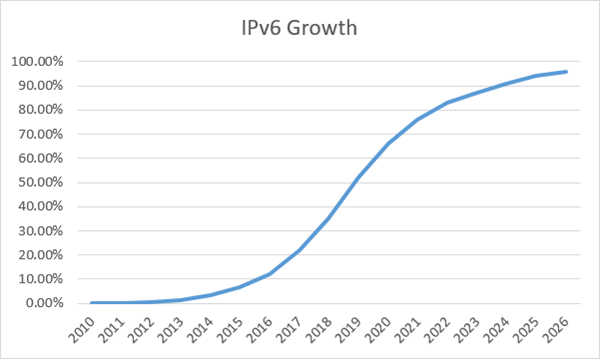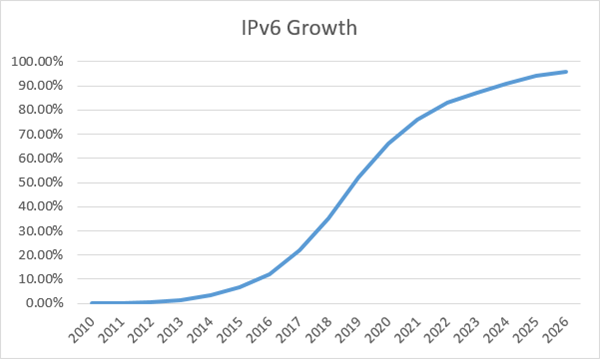We Only Know What We Can Measure
It should be a widely recognized rule at this point to completely disregard any IPv6 adoption prediction made by an IPv6 evangelist (especially this author). For that matter, trying to predict the future of rapid innovations in network technology can often be like grasping at straws. However, while the ultimate validity of predictions may vary, we can be certain about the recent history of Internet traffic measurements taken. There is evidence that 2016 witnessed IPv6 adoption continuing at an amazing rate. We have observed situations where IPv6 can even perform better than IPv4 and now have ways to measure the difference. Even though IPv6 adoption has been doubling every year for the past few years, IPv4 usage continues to rise as well. This requires us to consider the future of IPv4 as a legacy protocol.
Dual-Protocol Tipping Point
Still, some folks are operating under the misconception that they must move directly from running only IPv4 to running only IPv6. We know that IPv6 is not an all-or-nothing proposition and that all organizations as well as the Internet backbone itself will pass through a dual-protocol transition period. For every Facebook stream that loads over IPv6, there will be one less Facebook stream that loaded over IPv4. The dual-protocol end-nodes and their users will be oblivious to the transport protocol used for the connection – they just want to see what their friends are posting. For every Google search performed over IPv6, there was one fewer search results page delivered over IPv4; the search results are the same, regardless of the network transport. At some point there is a tipping point where the balance will start to shift from IPv4 to IPv6. We believe that this will come at some point but we just don’t know exactly when that tipping point will occur.
Predicting IPv4 and IPv6 Traffic Volumes
Martin Gysi (@MartinGysi) is one such afore-mentioned IPv6 proponents who is advancing the adoption of IPv6 and scientifically predicting the future of IPv6 adoption. Martin is a long-time IPv6 technologist, writer, presenter, and technical leader at Swisscom. He has been a presenter for (and is a member of) the V6 World Scientific Committee. He has also presented at Cisco Live, and has written for the Internet Society. Last year, Martin gave a presentation on the IPv6 deployment at Swisscom and his presentation included several predictions about the future. His presentation predicted when IPv6 Internet traffic would exceed IPv4 Internet traffic. On slides 13 and 14 of his presentation he made several bold claims about IPv4 and IPv6 Internet traffic (paraphrased by this author).
- IPv6 traffic is doubling every year, but IPv4 traffic is still 80% of all Internet traffic.
- IPv6 is at 20% and its assumes its share will increase by 10% per year.
- IPv6 will reach 50% in 2018.
- The percentage of CG-NAT users will increase to 20% by 2025.
- IPv6 off-loads traffic from CG-NAT.
- IPv4 traffic volume will peak in 2020.
- The amount of CG-NAT traffic will peak in 2021.
- No more IPv4 traffic will be present after 2024.
Martin also provided a chart that backs up his predictions with estimates of future traffic volumes.
His presentation caused me to consider how IPv6 is affecting IPv4 traffic volumes. In the remainder of this article, we will consider his mathematics and then perform our own “back of the napkin calculations” to validate predictions of IPv6 traffic growth and its effect on IPv4 traffic volumes.
IPv4 Internet Traffic Growth
The first step of this process is to try to determine how fast Internet traffic is growing. One source of data is the Cisco Visual Networking Index (VNI) Forecast for 2015 through 2020. From their research, Cisco predicts that “Annual global IP traffic will surpass the zettabyte (ZB; 1000 exabytes [EB]) threshold in 2016, and will reach 2.3 ZB by 2020. Global IP traffic will reach 1.1 ZB per year or 88.7 EB (one billion gigabytes [GB]) per month in 2016. By 2020, global IP traffic will reach 2.3 ZB per year, or 194 EB per month. Global IP traffic will increase nearly threefold over the next 5 years, and will have increased nearly 100-fold from 2005 to 2020. Overall, IP traffic will grow at a compound annual growth rate (CAGR) of 22 percent from 2015 to 2020.” From this and other sources, it seems that current Internet traffic volumes are increasing on average at around 30%, year-to-year. Wikipedia also has a page on “Internet Traffic” that includes a section on annual global Internet traffic amounts. From this data, we can create a table that combines the historical measurements with the average 30% annual growth percentage to create a prediction of the number of Petabytes (PB) per year of IPv4 Internet traffic. Here is the table that was created based on these assumptions about the future of total Internet traffic volumes.
IPv6 Adoption Percentage
The next step is to create a table that lists the percentage of Internet traffic that is IPv6 and also predicts the future of IPv6 growth. Many IPv6 proponents have often included screen shots of the Google’s IPv6 traffic statistics graph to show increasing IPv6 adoption. Back in 2009, Google was processing more than 20PB/day data. Before the year 2012, there was very little interesting on this IPv6 traffic graph, but after World IPv6 Launch, the numbers started to increase. With IPv6, we can expect that the yearly doubling of IPv6 traffic won’t last forever. It is more likely that we are in the period of acceleration between 2013 and 2018, but then after 2020, IPv6’s adoption will slow as it becomes more ubiquitous. There will be a long-tail on the IPv6 adoption curve where the substantial legacy IPv4 systems will take many years to age out of the infrastructure. Here is the table of the percentage of Internet traffic that is IPv6 and the future prediction of IPv6 traffic percentage.
What follows is a graph of this data that shows how IPv6 starts out slowly, moves through the period we are in now where traffic is doubling annually, then moves to a slower growth period as IPv6 reaches broad adoption. This is similar to a sine-wave shape we have seen repeated so many times in history.
Compare IPv4 and IPv6 Traffic Volumes
The next step is to subtract the IPv6 traffic amounts from the total Internet traffic amount that has historically been IPv4-only. We subtract the IPv6 amount from the IPv4 amount because transactions will occur over one or the other network-layer protocol, but not both at the same time. In situations where the Happy Eyeballs (RFC 6555) method is employed, dual-protocol applications are aggressive at establishing connections and attempt to connect over both IPv4 and IPv6 simultaneously. This is a measure to ensure that the end-user experience is the best it can possibly be regardless of which IP protocol has end-to-end connectivity. However, with Happy Eyeballs, this method only doubles the amount of traffic during initial connect, which is a small amount that we are considering not substantial and, therefore, insignificant for our calculations. When we graph the IPv4 and the IPv6 traffic volumes, it produces the following graph.
We can see in this graph that the IPv4 traffic volumes continue to increase, but then there is a cross-over point where IPv6 and IPv4 traffic volumes are equal. This appears to occur around the year 2018. At this point, IPv6’s growth starts to become significant relative to IPv4 traffic volumes and acts to level-off the growth of IPv4. This cross-over point may be approaching in the next few years. Recently the American Registry for Internet Numbers (ARIN) announced that 50% of their subscriber members now have registered IPv6 addresses and they continue to issue 60 to 100 requests each month. Now my graph looks surprisingly similar to Martin’s graph from slide 14.
Conclusions
Based on these results, we can endorse the conclusion that IPv6 will likely overtake IPv4. It appears that we have consensus that in the 2018 to 2019 timeframe, IPv6 traffic will cross the trajectory of IPv4. At that point, there will be equal portions of IPv4 and IPv6 traffic on the Internet. The discrepancies in our prediction of the cross-over point may come from the fact that I was not taking into account the effects of CGN/LSN. We also both conclude that by the 2024 to 2028 timeframe that there will be only trace amounts of IPv4 traffic on the Internet.
This post originally appeared on the Infoblox blog at https://community.infoblox.com/t5/IPv6-Center-of-Excellence/IPv6-is-Accelerating-as-IPv4-is-Nearing-its-Peak/ba-p/7992.
Scott Hogg is the Chief Technical Officer (CTO) for GTRI.


